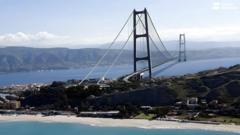The Shetland Islands, an archipelago known for its rugged landscapes and rich marine resources, are contemplating a transformative transport initiative inspired by the Faroe Islands. Faroese Prime Minister Aksel Johannesen advocates for the development of undersea tunnels to replace outdated ferry services, a move he claims could significantly enhance the economy and quality of life on Shetland. The Shetland Islands Council is pursuing plans for tunnels connecting four outlying isles, including Unst, the UK's northernmost inhabited island.
Investment in infrastructure has proven beneficial in the Faroe Islands, as Johannesen notes that their tunnel network has led to population growth and economic prosperity. In stark contrast, Scottish Salmon producer Anne Anderson expresses frustration over the lack of infrastructure progress in Scotland, suggesting that delays have affected industry competitiveness. With the Faroe Islands already boasting 23 tunnels—four of which run beneath the sea—advocates in Shetland argue it’s time to replicate successful models.
Former tunnel builder and expert Andy Sloan believes the technology used in the Faroese projects can be adapted for Shetland. With local knowledge and engineering support, the Shetland Islands could dramatically improve connectivity with nearby islands, bolstering their economy. However, this vision isn't without dissent. Some residents, while generally supportive, fear that such developments could alter the traditional island lifestyle, which is characterized by its unique ways of traversing the landscape.
Despite the excitement, the path forward is unclear. The costs associated with constructing an undersea tunnel network could potentially be high; hence, Shetland may consider a toll system similar to that of the Faroese model to finance the projects. Current ferry systems are aging and costly, accommodating hundreds of thousands of passengers each year. As infrastructure continues to age, advocates urge for innovative solutions, stressing the urgent need for development.
Council Leader Emma Macdonald underscores Shetland's essential role within Scotland, envisioning that these tunnels could lead to economic revitalization and enhanced accessibility. Many Shetlanders, including those from Saxavord Spaceport, believe that improved transport links would present modern business opportunities. A feasibility study has already been approved for the proposed tunnels, but significant government funding remains uncertain.
Though debates about possible changes to island life persist, many locals, like shop owner Pat Burns, have begun to reconsider their initial skepticism. She now sees tunnels as a necessity to combat logistical challenges exacerbated by poor weather and limited ferry capacity. The future of transport in Shetland hangs in the balance, and many eyes are watching to see if this island group will follow in the footsteps of their Faroese counterparts.



















